Brandenburg Gate to the southern seas: the first colonies of Germans in Africa and the West Indies
It is known that until the unification in the second half of the XIX century, Germany remained fragmented into many feudal states and "states". Among them were both more or less significant states like Prussia, and dwarf feudal possessions, which were in vassal dependence on more powerful politically, militarily and economically countries.
Attempts of colonial expansion were undertaken in the XVI-XVII centuries. a number of German states. Thus, the earliest example of the existence of a German colony in the New World can be called history domination in Venezuela of the banking name of the Belzer in the XVI century. It was connected with the fact that the Spanish king Charles I owed a large amount of money to the banks of Fugers and Belzers from Augsburg and, for payment, transferred them for some time to the colony of Venezuela (“Little Venice”), called by the German managers “Kleine Wendig”. The Welzers received Venezuela for management under a special agreement signed by 27 in March 1528, and in 1529, the first German arrived in the colony - Governor Ambrosius Singer. However, abuses of power and numerous crimes of the German authorities against the local population - both Indians and Spaniards, restored the Catholic Church, and then the Spanish crown, and in 1546, after 17 years, the Spanish king dissolved the Venezuelan treaty. Despite all the attempts to return the colony under their control, the Belzères could not control Venezuela anymore.
Another example of the attempted colonial expansion of one of the German states in Latin America is the history of Hanau-India. In July, 1669, on behalf of Count Friedrich Casimir von Hanau, his representative Johann Joachim Becher acquired the territory with a total area of 10 thousand km of 2 in Netherlands Guiana (present-day Suriname). On the land between the Amazon and Orinoco rivers, acquired from the Dutch West Indies Company, the creation of the Hanau-India kingdom was planned with the goal of humanizing the Indians. However, the authorities of the new colony faced a number of serious problems, among which one of the main problems was the lack of colonists who wanted to go to master the vast territory. On the other hand, Count von Hanau did not have enough money to equip a colony. Therefore, the attempt failed. In 1672, the count tried to sell the colony to the British, but to no avail. In the end, at the beginning of 1670's. the colony was abandoned.
An attempt to create a colonial empire by Brandenburg’s electorate, which came at the end of the 17th century, but a little later than the adventure of Count Hanau, looks far more serious and long-lasting. At least, the history of the Brandenburg colonial possessions dates back several decades, and the colonies themselves actually existed and left behind some traces still preserved.
Brandenburg - from devastation to sea voyages
In the 17th century, Brandenburg became one of the most serious states that existed at that time on the territory of modern Germany. This territory existed as a margraving with the center in the Brandenburg fortress from 1157, periodically changing hands - from one German feudal dynasty to another. So, in 1157-1320. Brandenburg was owned by Askania, in 1320-1373 - Wittelsbach, in 1373-1410. - To Luxembourg, and in 1411, the Hohenzollern dynasty established itself in Margrave. 30 April 1415 The emperor of the Holy Roman Empire assigned Frederick VI the Nuremberg title of hereditary margrave and elector of Brandenburg. Strictly speaking, it was the approval of the Hohenzollerns in power in Brandenburg that in many respects contributed to the strengthening of the political and economic positions of this German state. The accession of Brandenburg to the Reformation in Germany contributed to strengthening the position of the electors, since the church ownership was transferred to secular power and the elector became the largest owner in the state. In 1605, the electors of Brandenburg received the right of regency over the Duchy of Prussia, and when the last Prussian duke Albrecht Friedrich, who had no heirs, died in 1618, his possessions were completely under the control of the electors of the Hohenzollerns. Thus, personal union was concluded between the Brandenburg Mark and the Duchy of Prussia.
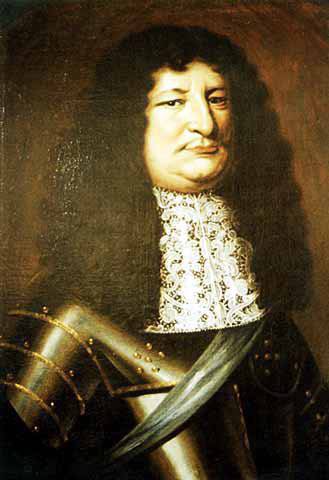 However, the entire first half of the seventeenth century was a rather difficult time for Brandenburg. Thirty Years War 1618-1648 had a negative impact on the socio-economic sphere of the life of the Brandenburg society. People died in the war, the country's economy was undermined, Brandenburg did not yet have a serious political weight in Europe due to these factors. Only the end of the war entailed a certain stabilization of the Brandenburg economy. The establishment in power of a strong figure, Elector Friedrich Wilhelm (1629-1688), who went down in history as the “Great Elector”, contributed to the improvement of the situation in the state. For his time, Friedrich Wilhelm was a fairly well-educated person - he studied in Holland, a leading country in those times where he mastered the art of warfare perfectly. Returning to Brandenburg, he was determined to substantially improve the life of the state, which he was soon to manage.
However, the entire first half of the seventeenth century was a rather difficult time for Brandenburg. Thirty Years War 1618-1648 had a negative impact on the socio-economic sphere of the life of the Brandenburg society. People died in the war, the country's economy was undermined, Brandenburg did not yet have a serious political weight in Europe due to these factors. Only the end of the war entailed a certain stabilization of the Brandenburg economy. The establishment in power of a strong figure, Elector Friedrich Wilhelm (1629-1688), who went down in history as the “Great Elector”, contributed to the improvement of the situation in the state. For his time, Friedrich Wilhelm was a fairly well-educated person - he studied in Holland, a leading country in those times where he mastered the art of warfare perfectly. Returning to Brandenburg, he was determined to substantially improve the life of the state, which he was soon to manage. In the year 1640, at the age of twenty, Frederick William ascended the throne. He made peace with Sweden and turned to the restoration of the country's seriously undermined economy. During the Thirty Years' War, the territory of Brandenburg has largely literally become empty. Many villages were burned down, about half of the inhabitants of the state perished or fled to other lands. The development of the country's economy required, first of all, the solution of demographic problems. Frederick Wilhelm began the common practice of inviting colonists from other, overcrowded countries. First of all, he drew attention to the hardworking and well-known for his puritanical dispositions of followers of Calvinism. As is well known, this current of Protestantism was most pronounced in Switzerland and Holland. The Dutch rushed to Brandenburg, who made a significant contribution to the revival and further development of the country's economy. Following the Dutch, the French began to arrive in the country - first of all, Protestants, who were subjected to religious discrimination in Catholic France. If the Dutch contributed to the development of gardening and cattle breeding, the French contributed to strengthening the industry. In total, the state has settled down to 20 thousands of French immigrants. Many of them were actively engaged in trade, others entered the civil service as land or naval officers, or civilian officials.
Creating marine fleet
The most important task for the Elector was the creation of a strong navy. Having received a part of Pomerania at the end of the Thirty Years' War, Elector Friedrich Wilhelm began to think about expanding the trade relations of the state, which also required the development of maritime communications. So the idea of acquiring their own overseas colonial possessions arose. The elector wanted to take an example of development from the neighboring Netherlands - also a Protestant state, which went to the North Sea coast and played a key role in world maritime trade. The Swedish-Brandenburg War contributed even more to the growth of the “appetites” of Brandenburg.
Strictly speaking, it was not so much the Swedish-Brandenburg War, as the war of Denmark and Sweden, which took place on the territory of the modern North German lands. In 1672, a war broke out between France and Holland, in which England and Sweden acted on the side of France, and Denmark, the Holy Roman Empire with the majority of German feudal rulers, Brandenburg, Spain acted on the side of Holland. In 1675, Danish and Brandenburg troops invaded Swedish Pomerania (at that time Pomerania belonged to Sweden), the Swedish fleet suffered a series of defeats from the Danish-Dutch, and the Swedish ground forces from the Brandenburg army. Nevertheless, the war, thanks to the actions of France, ended in a peace treaty between Sweden and Denmark. For Brandenburg, the consequence of the war was the acquisition of a part of Pomerania and the creation of its own navy. Koenigsberg became the main seaport of Brandenburg, and in 1680 several frigates with artillery weapons were manufactured. Although, of course, Brandenburg could not stand any competition with other European powers of the “first echelon” - so, if the elector in 1680 had only 28 ships, then the Dutch had 16 000 ships. Nevertheless, they were very suspicious of the emergence of a new naval force in the Baltic Sea. The French took the appearance of the Brandenburg fleet quite negatively.
At the origins of the creation of the Brandenburg Navy and, by and large, the colonial expansion in Africa, was Benjamin Raoul. He came from a family of Huguenots who formerly lived in South Flanders, who emigrated to Brandenburg after the Elector allowed the acceptance of Huguenot refugees and more French and Flemish Huguenots arrived in Brandenburg on 20 000.
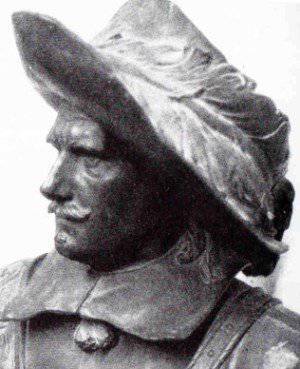 In 1676, it was Raoul who was instructed to create the Brandenburg Navy, since he already had a great deal of maritime experience and was also professionally engaged in trading activities. In turn, Raoul agitated in every possible way the Brandenburg Elector in favor of the need not only to create a navy, but also to develop maritime trade, which was not possible without colonial expansion into the southern lands.
In 1676, it was Raoul who was instructed to create the Brandenburg Navy, since he already had a great deal of maritime experience and was also professionally engaged in trading activities. In turn, Raoul agitated in every possible way the Brandenburg Elector in favor of the need not only to create a navy, but also to develop maritime trade, which was not possible without colonial expansion into the southern lands. Deciding to embark on a colonial expansion, Brandenburg drew attention to the territories that were of the greatest economic interest to European states at the appointed time. As you know, the most popular areas in the XVII century were: in Asia - the Indian coast and islands of the Malay Archipelago, in Africa - the coast of the Gulf of Guinea (the territory of modern Ghana, Benin, Togo), in America - the islands of the West Indies. Despite the possible competition from other European countries, Brandenburg decided to try his luck and acquire his own African and West Indian possessions.
A Brandenburg-African company was created, whose tasks included maritime trade and the development of new lands. At the same time, the company received the right to use the Brandenburg Navy to protect its interests. At the origins of the company just stood Dutch immigrants, well-versed in maritime trade and navigation. In 1682, Elector Friedrich Wilhelm decided to create a Brandenburg-African company. The relevant decree was signed by 7 March 1682 of the year. The impetus for this decision was the first trip to West Africa under the Brandenburg flag. Benjamin Raoul and his companions took the costs of carrying it out; however, the Brandenburg Elector granted the right to use the Brandenburg flag for the expedition, which provided some protection against allegations of piracy or smuggling. Raoul and his partners received from the Elector a mandate to trade in gold, ivory, slaves and to deliver these goods from the Guinean coast to Lisbon, Cadiz and other European ports. Since 1684, the office of the Brandenburg-African company operated in the city of Emden, while Raoul and his associates had thirty merchant ships and ten warships that served as the fleet of the company controlled by the Brandenburg Elector.
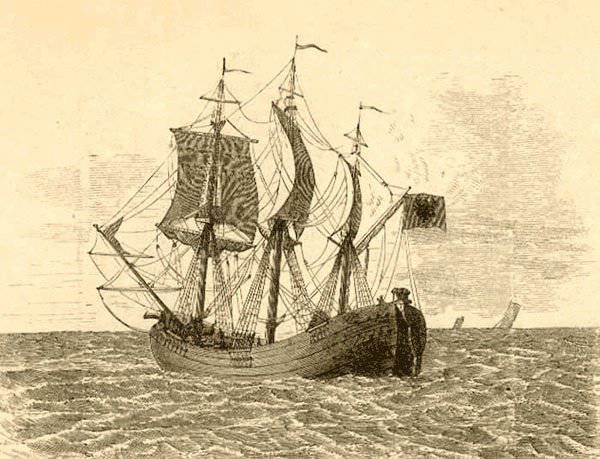
The sea expeditions of Brandenburg began shortly after the creation of the Brandenburg Navy. The task was to explore the African coast and, if possible, to develop trade with local tribes. In May, the first Brandenburg expedition 1681 managed to visit the Gold Coast (the territory of modern Ghana) and conclude a trade agreement with the leaders of the local Ashanti tribes. The latter allowed Brandenburg to build their own trading station and armed residence on the Gold Coast during the year to ensure trade between Brandenburg and the local population. In response, Brandenburg promised to provide all possible assistance to the leaders of the local tribes in the fight against enemies, as well as to supply weapons and some other European goods valued here.
Gross-Friedrichsburg and other colonies in Africa
To create the Brandenburg trading post on the Gold Coast, it was decided to send the next expedition there. December 27 On the Gold Coast, two Brandenburg frigates arrived, Morian and Chur Prinz. The first frigate was armed with 1682 guns and had 12 sailors and crew officers under the command of captain Blond. On the second frigate were 40 guns and 32 officers and sailors under the command of Captain Foss. In addition to the ship's crews, the frigates were ground servicemen - engineers Walter and Loigeben, 60 sergeant, 2 corporal, 2 military musician and a combined squad of 2 musketeers recruited in Brandenburg infantry regiments.
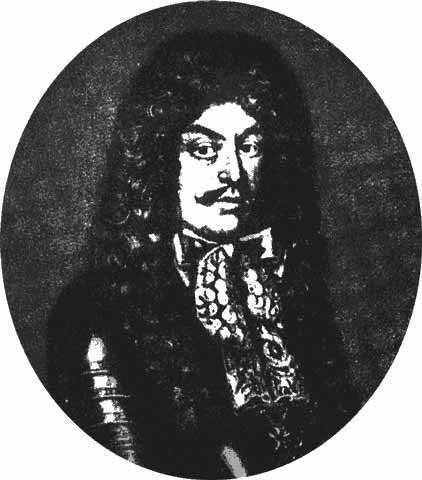 The general command of the expedition was carried out by the camera-Junker Major Otto Friedrich von der Gröben (1657-1728). It was one of the prominent military and state leaders of Brandenburg - Prussia in the XVII-XVIII centuries. He was born in the family of the Brandenburg Major General Georg Heinrich von der Gröben and received, despite the Protestant denomination, an education in a Jesuit school in the Warmian Diocese. In his early years he traveled a lot as a privateer, visited Egypt, Palestine and Cyprus, served as a soldier in the Spanish army, then returned to 1680 in Brandenburg, where he entered the military and court service. Since von der Gröben had an impressive experience in traveling, including African ones, it was the elector who chose him when he appointed the head of the second expedition of the Brandenburg fleet to West Africa.
The general command of the expedition was carried out by the camera-Junker Major Otto Friedrich von der Gröben (1657-1728). It was one of the prominent military and state leaders of Brandenburg - Prussia in the XVII-XVIII centuries. He was born in the family of the Brandenburg Major General Georg Heinrich von der Gröben and received, despite the Protestant denomination, an education in a Jesuit school in the Warmian Diocese. In his early years he traveled a lot as a privateer, visited Egypt, Palestine and Cyprus, served as a soldier in the Spanish army, then returned to 1680 in Brandenburg, where he entered the military and court service. Since von der Gröben had an impressive experience in traveling, including African ones, it was the elector who chose him when he appointed the head of the second expedition of the Brandenburg fleet to West Africa. In addition to the soldiers, the ships delivered a certain amount of building materials to the African coast - for laying the fortifications and administrative buildings of the colony. Having landed on the Gold Coast, the Brandenburg Expedition founded the colony Gross-Friedrichsburg, named after the Elector Friedrich Wilhelm. 1 January 1683 was held a solemn raising of the flag of Brandenburg on the land of the Gold Coast. The leaders of the 14 local tribes, gathered by Major von der Greben, signed an agreement to go under the protection of Brandenburg. In two years, two forts were built on the territory of the Gold Coast and a fortification in the area of Takkorari.
The serf garrison consisted of a detachment of 91 Brandenburg soldiers and recruited native soldiers on the Gold Coast 130. Thus, Brandenburg acquired its own small colonial troops, created according to the classical scheme - from local warriors and a squad of Europeans training them. The need for local warriors was particularly relevant due to tropical diseases, to which the Brandenburg soldiers who arrived from Germany were extremely susceptible. Even during the construction of fortifications, sometimes only five people from 40 soldiers worked. Both sergeant engineers died, Major Fon der Gröben himself became seriously ill with tropical fever. In July-August, 1683 von der Gröben returned to Hamburg aboard the Morian ship, and the captain of the Morian Philip Petersen Blonk was appointed new commandant and head of the fort construction. During the 1683-1685. warehouse and administrative buildings were built. Four massive bastions of the fortress were equipped with large-caliber 32 guns. In the courtyard of the fort was built several two-story buildings that served as administrative, auxiliary and residential buildings. It also housed the Brandenburg garrison.
The main objective of the presence of Brandenburg on the Gold Coast was the slave trade. In order to capture further bridgeheads, the Brandenburg detachment attempted to advance inland, but these attempts were quickly stopped by the Dutch, who owned larger factories on the Gold Coast and played a much more prominent role in the transatlantic slave trade. Ultimately, the Brandenburg leadership had to abandon plans for the colonization of the entire Gold Coast and stop at the already created outposts.
Gross-Friedrichsburg became the main center of the Brandenburg presence on the coast of West Africa. However, only the outposts on the Gold Coast of the Brandenburg colony in this region of the world were not limited. So, at the turn of the XVII-XVIII centuries. On the coast of the modern state of Togo (Slave Coast), a Brandenburg outpost functioned in the Vida colony. In addition to the Brandenburg trading post, the British and the Dutch acted here as well. Unlike Gross-Friedrichsburg, the colony in Vid was not purely Brandenburg and did not have fortifications - only a trading post and warehouses. However, it was through this colony that a large part of the slave trade with the West Indies was carried out.
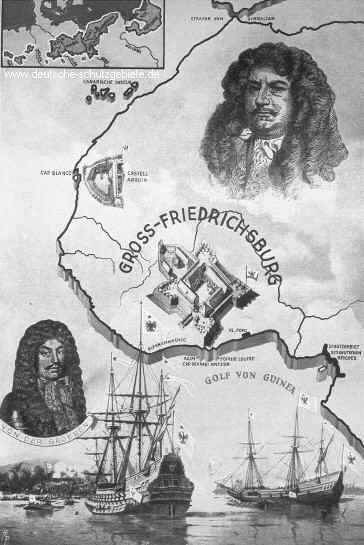 5 October 1685, two years after landing on the Gold Coast and the creation of Gross-Friedrichsburg, a detachment of the Brandenburg-African Company, arrived on the frigate Rother Lowe, landed on the island of Arguin. This island is located off the coast of modern Mauritania and is currently owned by this state. However, at that time he was temporarily “no one’s,” that is, he was not in the sphere of interests of any European state. Formerly a Portuguese trading post existed on Arguin, but then it was abandoned. Brandenburg detachment restored abandoned Portuguese fort. The captain of the frigate Cornelius Reers signed an agreement with the local leader on the recognition of the Brandenburg Protectorate by Arguin. The contract was confirmed in 1687, ratified in 1698. Since Arguin had a very favorable geographical position, he became one of the important shopping centers. However, unlike Vida and Gross-Friedrichsburg, Arguin was trading not so much a “living commodity” as a rubber.
5 October 1685, two years after landing on the Gold Coast and the creation of Gross-Friedrichsburg, a detachment of the Brandenburg-African Company, arrived on the frigate Rother Lowe, landed on the island of Arguin. This island is located off the coast of modern Mauritania and is currently owned by this state. However, at that time he was temporarily “no one’s,” that is, he was not in the sphere of interests of any European state. Formerly a Portuguese trading post existed on Arguin, but then it was abandoned. Brandenburg detachment restored abandoned Portuguese fort. The captain of the frigate Cornelius Reers signed an agreement with the local leader on the recognition of the Brandenburg Protectorate by Arguin. The contract was confirmed in 1687, ratified in 1698. Since Arguin had a very favorable geographical position, he became one of the important shopping centers. However, unlike Vida and Gross-Friedrichsburg, Arguin was trading not so much a “living commodity” as a rubber. Attempts to expand into the Caribbean
Tasks for the successful development of the transatlantic slave trade required the creation of their own strongholds on the islands of the Caribbean. Otherwise, Brandenburg would have to use the ports of other states, which would either present financial difficulties or would not seem possible at all due to the opposition of competitors. Therefore, the Brandenburg-African company, simultaneously with the creation of colonies on the coast of West Africa, began to search for free territories in the Caribbean. This seemed far more difficult, since the West Indies had long been colonized by other European states, representing a field of constant opposition. However, Brandenburg did not have any other way, not being able to compete with England, Spain or Holland - large colonial predators, drew attention to the possession of the weaker European states. It was possible, if not to conquer them, then at least to rent them, since the countries of the "second echelon" often could not contain overseas colonial possessions and were themselves glad to get rid of them more favorably.
25 November 1685 was entered into a lease agreement for part of the island of San Thomas. It is known that this island in the period described belonged to the Danish West India Company. The contract provided that San Thomas remains the property of Denmark, but the rights to use the leased territory are transferred for a period of thirty years to Brandenburg. The island also received the status of a free port, which was extremely important for the development of the supply of slaves from the West African possessions of Brandenburg. However, in 1693, Brandenburg, feeling that the Danes were not very puzzled by the retention of control over the whole island, and also did not have serious forces to render resistance, annexed the leased part of the island of San Thomas. In 1689, on the island of Vieques, Brandenburg annexed another colony of the Danish West India Company, founded in 1682. However, it existed for a short time - from 1689 to 1693. In 1696, the Prussian king Frederick I, who was next to Elector Friedrich Wilhelm, also bought the island of Tertolene, where an attempt was made to create another West Indian colony. The emergence of colonies in the Caribbean contributed to the renaming of the Brandenburg-African Company to 1692 to the Brandenburg-African-American Company.
Sunset and end of the Brandenburg colonies
The first time the Brandenburg colonies existed in West Africa, they brought a fairly good income to the Brandenburg-African company, and then to the crown, since in 1689 all the company's shares were bought by the elector. In total, at least 19 thousands of African slaves were taken out of Brandenburg trading post in West Africa. But trade was not limited only to the export of slaves — rubber, ivory, ostrich feathers, and gold were exported. Nevertheless, Brandenburg was unable to carry out further colonial expansion in West Africa - the country could not withstand competition from the countries of Western Europe that were more successful in maritime trade — England, Holland, Portugal, and France. The latter acted much more actively, which ultimately led the Brandenburg colonies in Africa to a gradual decline. Moreover, the Brandenburg garrison in the same Gross-Friedrichsburg experienced difficulties with financing, material support, plus soldiers, officers and officials suffered from local tropical diseases. But the decisive role was played by the blockade of the North Sea by the British and the Dutch, who feared the growing influence of Brandenburg after Elector Frederick Wilhelm moved the country's main port from Koenigsberg in the Baltic Sea to Emden. Thus, the Brandenburg ships were deprived of the possibility of unhindered passage into the Atlantic Ocean.
As a result, in the first half of the XVIII century begins the decline of a small colonial empire of Brandenburg. Brandenburg-African-American company ships less frequently made commercial flights, and the trips that took place often resulted in attacks by pirates and serious losses. The Brandenburg Navy, due to the blockade of the North Sea by the British and the Dutch, was not able to defend its merchant ships from pirate raids. During the 1699-1709. only a few ships of the Brandenburg-Afrkian-American company made trade flights to the African and Caribbean colonies. In 1711, the company was acquired by King Frederick in state ownership and actually ceased operations - the king over the next two decades focused his efforts only on selling the company's property and finding buyers. Such a sad result of the thirty-year existence of the Brandenburg-African-American company could not but affect the existence of the Brandenburg colonies themselves. Soon they actually ceased to exist.
In 1716, the Brandenburg garrison left Gross-Friedrichsburg. In 1717, the king of Prussia (the electors began to wear this title from 1701 onwards), Friedrich sold Gross-Friedrichsburg to the Dutch, earning 7200 ducats and 12 African slaves for that — a mere song. However, the situation unfolded in the most unexpected way - before leaving Gross-Friedrichsburg, his Brandenburg commandant Dubois handed over the command of the fort to the local African leader Jan Connie, who swore allegiance to the King of Prussia. When the Dutch arrived at the fortress to take possession of the property, Jan Connie refused to give them the fort Gross-Friedrichsburg, stating that it was the property of the Prussian crown. The Dutch squad attempted a forceful seizure of the fort, but was pushed aside by the defenders of the fortress. As a result, for several years the war between the Dutch colonial forces and the squad of Jan Connie lasted. Only in 1725, after 8 years after the sale of the fort of Holland, did Jan Connie and his associates retreat to the jungles of the Gold Coast, while not forgetting to take the Brandenburg flag with them - so that it would not get to the new owners of the fort.
After the arrival of the Dutch, Gross-Friedrichsburg was renamed Fort Hollandia, but did not show proper attention to it and the colony gradually declined. In 1815, the fort was finally abandoned by its Dutch owners, and after a while, like the whole territory of the Gold Coast, it became part of the British colony Gold Coast. Today, these lands are part of the territory of sovereign Ghana, and the remains of the Brandenburg Fort are the object of UNESCO and one of the local attractions. 9 March 1721 The island of Arguin off the Moorish coast, 34 of the year belonging to Brandenburg, was annexed by France.
The loss of the West African possessions was accompanied by a loss of interest in the outposts in the Caribbean - now Prussia simply did not need them. In 1720, the colony on the island of San Thomas was abandoned.
Thus, by the beginning of the 1720's. Brandenburg-Prussia officially lost all of its colonial possessions in West Africa and the Caribbean. Fate proved unfavorable to the German states in terms of colonial conquests. Only after a century and a half, at the end of the 19th century, after the unification of Germany, its colonial expansion began, which ended more or less successfully - before the defeat in World War I, Germany owned a number of vast colonies in Africa and Oceania, becoming a fairly successful colonial power.
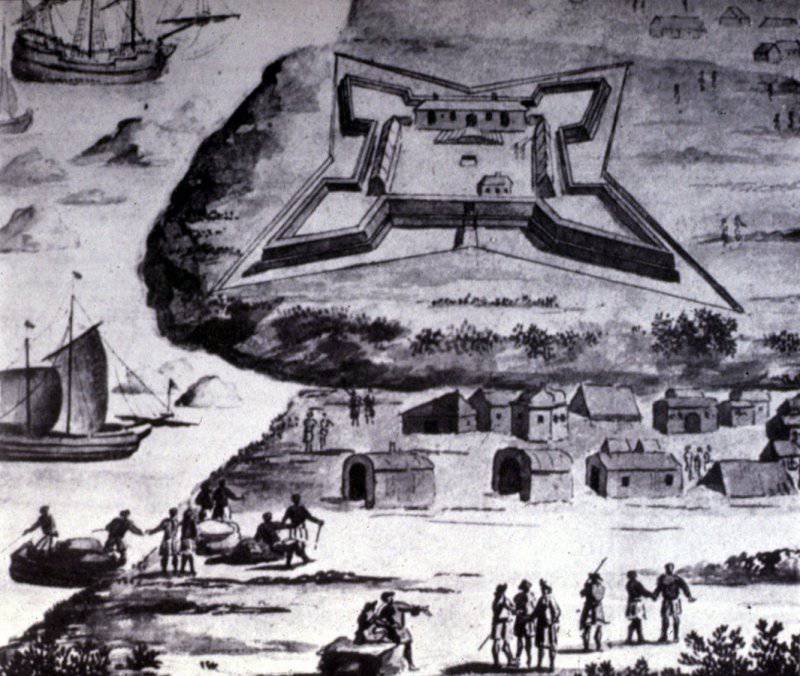
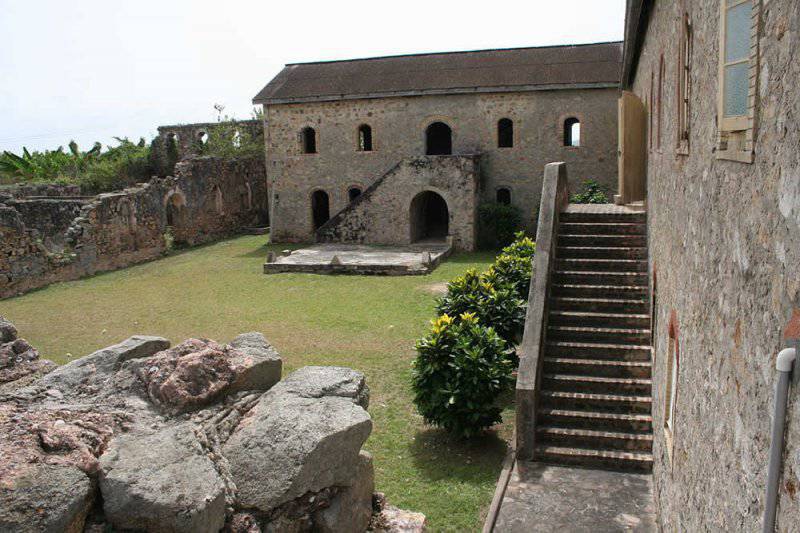
Information